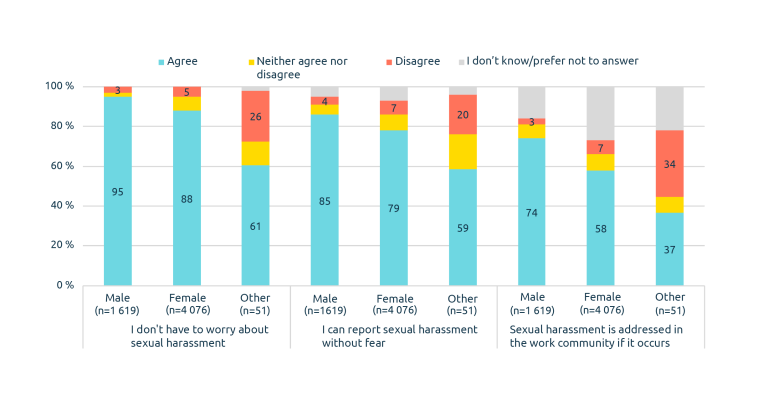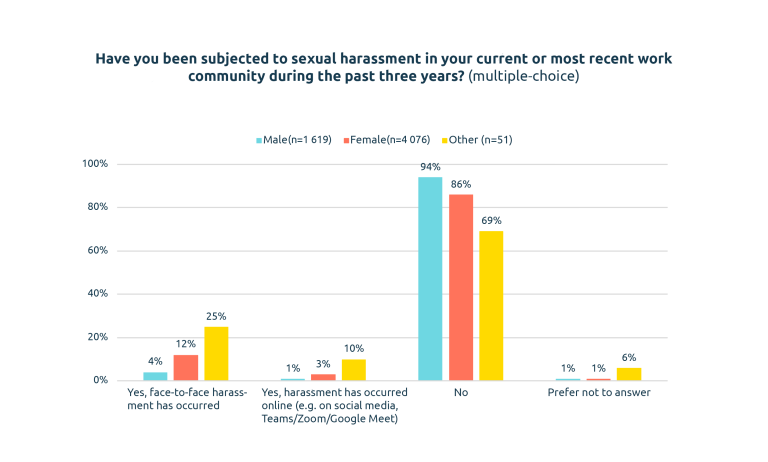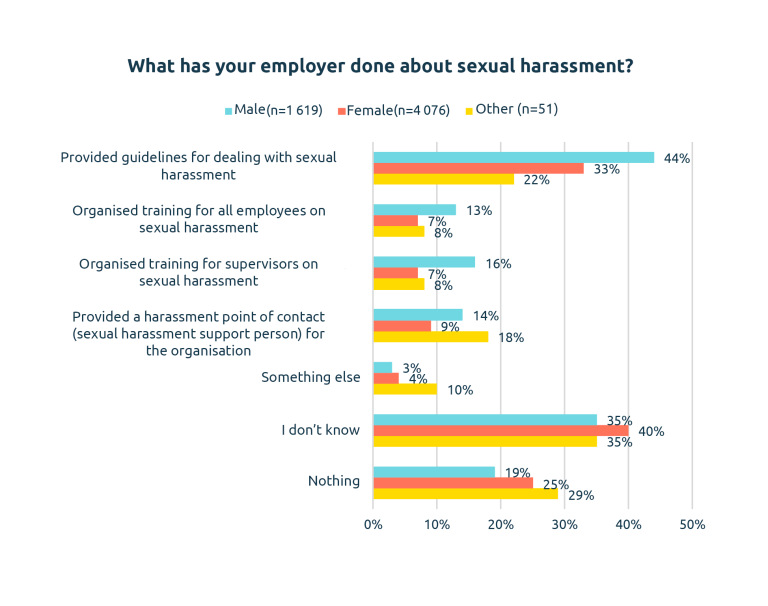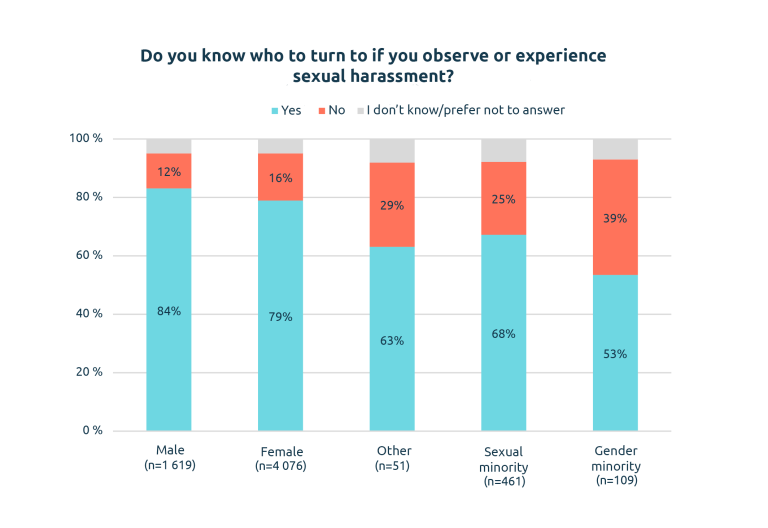
Text edited 2.9. 14:30: term spesifications & text fluency.
Sexual harassment is still a problem in Finnish work life. Although the majority of the respondents in the survey among Akava affiliates have not experienced sexual harassment at work, experiences of harassment were significantly more common among women and non-binary people than men.
17 Akava affiliates examined sexual harassment in a joint survey conducted in May–June 2023. This article examines selected results of the survey by gender and from the perspective of LGBTQIA+ respondents. The full results of the survey can be found here in Finnish.
Harassment climate at the workplace
Climate at the workplace was examined using statements, three of which were related specifically to sexual harassment. As shown in Figure 1, there are significant differences between genders.
The situation looks good for men: almost all men (95%) report that they do not have to fear sexual harassment and the majority (85%) say that they can report harassment without fear. In addition, three out of four men (74%) believe that possible harassment would be addressed in their workplace.
The majority of women (88%) also state that they do not have to fear sexual harassment and that they can report harassment without fear (79%). However, women are not as convinced as men that harassment would be addressed in their workplace: 58 per cent agree, 7 per cent disagree and 27 per cent are not sure.
Respondents who identified their gender as ‘other’ were least confident about their workplace addressing any instances of sexual harassment that may occur: one in three (34%) disagreed with the statement, and only a slightly higher number (37%) agreed with it. Moreover, about one in four (26%) non-binary individuals fear sexual harassment in their workplace and feel that they can report harassment without fear less often than the other genders (59% agree, 20% disagree). These results are concerning.

The harassment climate looks just as grim for gender minorities as it does for non-binary respondents (Table 1). 22 per cent report that they fear sexual harassment, one in four (25%) are unable to report harassment without fear, and 26 per cent doubt that any harassment would be addressed.
Respondents from sexual minorities, on the other hand, have a slightly more positive view of the situation (Table 1). Based on previous studies, it appears that men from sexual minorities perceive the situation as better compared to women and non-binary people (in the field of tech, for example: Student Survey 2021).
| Agree | Neither agree nor disagree | Disagree | I don’t know/prefer not to answer | ||
| I don't have to worry about sexual harassment | sexual minorities (n=461) | 78 | 10 | 12 | 0 |
| gender minorities (n=109) | 63 | 14 | 22 | 2 | |
| I can report sexual harassment without fear | sexual minorities (n=461) | 67 | 15 | 12 | 6 |
| gender minorities (n=109) | 58 | 14 | 25 | 4 | |
| Sexual harassment is addressed in the work community if it occurs | sexual minorities (n=461) | 49 | 12 | 11 | 27 |
| gender minorities (n=109) | 42 | 14 | 26 | 19 |
Table 1. Statements on sexual harassment at work, LGBTQIA+ minorities.
Experiences of sexual harassment

The percentage of respondents who had not experienced harassment was the highest (94%) among men and the lowest (69%) among non-binary people (Figure 2). Despite the majority of the respondents not having experienced harassment, experiences of sexual harassment were significantly more common among women and non-binary people than men. 12 per cent of women reported experiencing face-to-face sexual harassment in their workplace in the past three years, and 3 per cent had experienced harassment online. The corresponding figures for men are 4 and 1 per cent.
The survey indicates that experiences of sexual harassment are alarmingly common among LGBTQIA+ minorities. No less than 25 per cent of non-binary people reported having experienced face-to-face harassment and 10 per cent had experienced online harassment (Figure 2). Experiences of sexual harassment were even slightly more common among respondents from gender minorities: 28 per cent said that they had experienced face-to-face harassment and 10 per cent had experienced it online (Table 2). As for sexual minorities, one in five (20%) had experienced face-to-face harassment and 5 per cent online.
| Have you been subjected to sexual harassment in your current or most recent work community during the past three years? (multiple-choice) | sexual minorities (n=461) | gender minorities (n=109) |
| Yes, face-to-face harassment has occurred | 20 % | 28 % |
| Yes, harassment has occurred online (e.g. on social media, Teams/Zoom/Google Meet) | 5 % | 10 % |
| No | 77 % | 65 % |
| Prefer not to answer | 2 % | 6 % |
Table 2. Experiences of sexual harassment, LGBTQIA+ minorities.
The most common type of sexual harassment was verbal (Table 3). Non-binary respondents had also experienced physical and/or non-verbal harassment and the sending of an image or images much more frequently than men or women. Inappropriate comments in an electronic channel have been experienced least frequently by men (12%), and most frequently by non-binary people (54%) and gender minorities (47%). Inappropriate comments in electronic channels have also been directed at women and sexual minorities (19% and 27%) more often than men.
| What kind of sexual harassment have you experienced? (multiple-choice) | Male (n=78) | Female (n=530) | Other (n=13) | Sexual minorities (n=99) | Gender minorities (n=32) |
| verbal | 82 % | 84 % | 92 % | 86 % | 97 % |
| non-verbal | 23 % | 21 % | 46 % | 24 % | 34 % |
| physical | 28 % | 30 % | 69 % | 27 % | 34 % |
| sending of an image or images | 8 % | 6 % | 31 % | 8 % | 13 % |
| inappropriate comments in an electronic channel | 12 % | 19 % | 54 % | 27 % | 47 % |
| other | 5 % | 4 % | 0 % | 3 % | 0 % |
Table 3. Type of sexual harassment experienced, respondents who have experienced harassment by gender and LGBTQIA+ minority status.
Employer's measures

Men tend to either know or assume, significantly more often than women and non-binary people, that their employer has taken active measures to prevent harassment (Figure 3). For example, 44 per cent of men state that their employer has established guidelines for dealing with sexual harassment, while 33 per cent of women and 22 per cent of non-binary respondents say the same.
It is furthermore concerning that the groups that experience the most harassment say less often that they are aware of who to turn to when faced with harassment than other groups (Figure 4). Whereas about 80 per cent of men and women say they know who to turn to, 63 per cent of non-binary people and only just over half (53%) of gender minority respondents say the same. Correspondingly, up to 39 per cent of gender minority respondents say that they do not know who to turn to.

In conclusion
Employers should actively monitor the workplace for signs of harassment and intervene with any harassment on their own initiative. Harassment can also be prevented, for example by establishing a code of conduct that outlines the standards of good behaviour at work and by making sure that everyone in the workplace is aware that harassment is systematically addressed.
Based on the survey, harassment climate at work for people of other gender and gender minorities is more worrisome than for men or women. Respondents who belong to sexual or gender minorities experience more harassment and are also less confident that their employer would address harassment. Similar results were also found in a study by UN Women Finland (in Finnish).
In the open answers, the situation of LGBTQIA+ minorities and the difficulty of intervening in incidents are described as follows, for example:
- For example, situations where someone makes transphobic jokes that are not directed at anyone in particular, but are still inappropriate, are tricky. Intervening is challenging and we could really use some support and tools and some kind of go-ahead signal from the employer.
- A person from a gender minority has to listen to constant discriminatory joking. It’s hard to intervene, because the (male) majority does not have any problems.
Based on the results of this survey, there is still much room for improvement when it comes to addressing sexual harassment and preventing it at work. In addition, there is a lot of uncertainty around the topic, so staff awareness of guidelines (if they exist) etc. should be improved.
Read more about sexual harassment at work in a report by Statistics Finland (in Finnish)
How the survey was conducted
The survey on sexual harassment and sexism at work was conducted among 17 affiliates of Akava. The survey was conducted by Taloustutkimus 30 May – 18 June 2023 and it received responses from 5,931 people.
The affiliates involved were: Finnish Association of Academic Agronomists, Akava Special Branches, AKI-unions, the Union of Professional Engineers in Finland, the Association of Finnish Lawyers, the Finnish Union of Church Youth Workers, the Union of Technical Professionals KTK, the Finnish Association of Rehabilitation Professionals, the Union of Professionals in Natural, Environmental and Forestry Sciences Loimu, Talentia Union of Professional Social Workers, the Finnish Business School Graduates, the Finnish Veterinary Association, the Finnish Medical Association, Academic Engineers and Architects in Finland TEK, Professionals of Business and Technology, Social Science Professionals and YTY – Association for Managers and Professionals.
The target population consisted of the members of the affiliates who are participating in the labour market and students. The invitation to the survey was sent to almost 168,000 people and the response rate was 4%. Although the rate is low, the number of respondents was high, so the results could be statistically analysed. In addition, since the aim of the survey was to form a better understanding of sexual harassment and sexism as a phenomenon in work life, the possible bias in the respondent population was not seen as problematic.
Data collection was done in three languages (Finnish, Swedish and English). The affiliates sent the link to their members (either to a random sample of their members or to all members) and were also responsible for sending reminder messages.
This article uses descriptive methods (frequencies, cross-tabulations).
The terms used in the survey were defined on the survey form was follows:
- In this survey, sexual harassment means any verbal, non-verbal or physical conduct of a sexual nature which is committed with the purpose or effect of violating the mental or physical integrity of a person, in particular by creating an intimidating, hostile, degrading, humiliating or oppressive environment.
- Sexism refers to acts or views that belittle, oppress or discriminate a person based on their gender, gender identity or gender expression.
- Sexual minority refers to people who are not heterosexual in their sexual orientation. Sexual minorities include gays, lesbians, asexuals and bisexuals, for example.
- Gender minorities is an umbrella term used to refer to persons who do not identify with a defined gender at birth or whose gender, expression and experience do not in all or some ways correspond to normative notions of gender and who themselves identify with a gender minority, such as transgender, transvestite, non-binary or intersex people.
What topics does TEK study?
We at TEK are constantly researching the field of technology: employment, salaries, equality, and coping with work or studies, for example. We have studied and published information on many themes for years – you are welcome to examine and compare the results using, for example, time series visualisations.